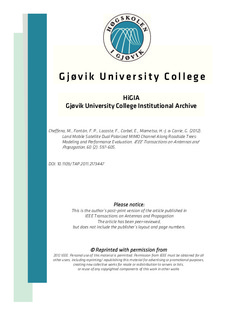Land Mobile Satellite Dual Polarized MIMO Channel Along Roadside Trees: Modeling and Performance Evaluation
Cheffena, Michael; Fontán, Fernando Pérez; Lacoste, Frederic; Corbel, Erwan; Mametsa, Henri-Jose; Carrie, Guillaume
Journal article, Peer reviewed
Permanent lenke
http://hdl.handle.net/11250/142587Utgivelsesdato
2012Metadata
Vis full innførselSamlinger
Originalversjon
Cheffena, M., Fontán, F. P., Lacoste, F., Corbel, E., Mametsa, H.-J. & Carrie, G. (2012). Land Mobile Satellite Dual Polarized MIMO Channel Along Roadside Trees: Modeling and Performance Evaluation. IEEE Transactions on Antennas and Propagation, 60 (2): 597-605. http://dx.doi.org/10.1109/TAP.2011.2173447Sammendrag
We present a novel physical-statistical, generative
model for the land mobile satellite (LMS), dual polarized,
multiple-input-multiple-output (MIMO) channel along tree sided
roads. Said model is parameterized by means of a physical
model based on the Multiple Scattering Theory (MST) which
accounts for the signal attenuation and scattering by trees.
Moreover, Finite-Difference Time-Domain (FDTD) electromagnetic
computations were performed to characterize the scattering
pattern of an isolated tree, and to calculate the MIMO
shadowing correlation matrix required by the model, and not
provided by MST. This modeling framework also encompasses
the single-input-multiple-output (SIMO)/space diversity case. To
illustrate the capabilities of the developed model, time series
were generated and used in system performance calculations.
The obtained results give an insight into the advantages of
dual polarized MIMO and SIMO/space diversity techniques in
these very frequent scenarios, and may help service providers in
evaluating the technical feasibility of such systems.
Beskrivelse
This is the author’s post-print version of the article published in
IEEE Transactions on Antennas and Propagation
The article has been peer-reviewed,
but does not include the publisher’s layout and page numbers. Reprinted with permission from IEEE. Access to the published version may require journal subscription: http://dx.doi.org/10.1109/TAP.2011.2173447
